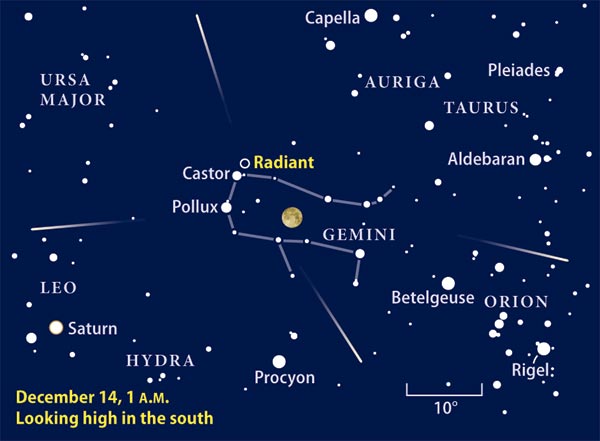
Tools to help you observe the Geminids
StarDome
Astronomy.com’s interactive star chart, StarDome, displays an accurate map of your sky. It’ll help you locate this spectacle. Astronomy magazine subscribers have access to a slew of cool functions with StarDome PLUS.
Video
Enjoying a meteor shower requires only comfort and patience. Senior Editor Michael E. Bakich gives tips on spending a night under “shooting stars.” Watch the video “How to observe meteor showers”.
December 11, 2008
One of the year’s most prolific meteor showers makes its appearance in mid-December. The Geminid shower peaks the night of December 13/14. Although frequently considered a poor cousin to August’s Perseid shower, the Geminids often put on a better show. In a good year, observers can expect to see more than 60 “shooting stars” per hour — an average of better than one per minute — at the Geminids’ peak.
Unfortunately, 2008 isn’t the best year for the Geminids. The Moon reaches its full phase December 12 and won’t appear much different the following night. With bright moonlight in the sky essentially from dusk to dawn, fainter meteors will be washed out, and only the bright ones will shine through. Under clear skies, attentive observers should see 10 to 15 meteors per hour — not great, but better than all but a handful of nights during 2008.
One way to compensate for the Moon’s presence is to find a spot where a building or tree blocks the Moon from view. This will make the sky appear darker. Also, try to observe from a rural location, where city lights won’t add to the Moon’s glow. Because December nights tend to be cold, bundle up in layers if you plan to view the Geminids. Reclining in a lawn chair is a great way to take in a lot of the sky at once, but be sure to get up and walk around occasionally. It also helps to drink some hot coffee or tea.
The Geminids begin as tiny specks of dust that hit Earth’s atmosphere at 81,000 mph (130,000 km/h), vaporizing from friction with the air and leaving behind the streaks of light we call meteors. The meteors appear to emanate from the constellation Gemini the Twins (hence their name), near the bright stars Castor and Pollux. You can find this area in the eastern sky during the early evening hours and nearly overhead after midnight.









